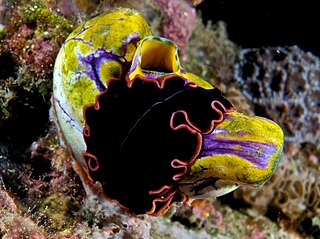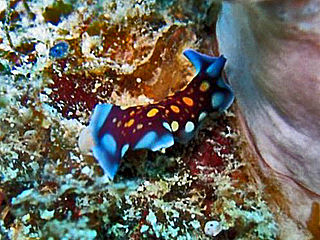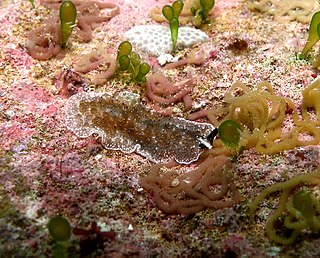
Penis fencing is a mating behavior engaged in by many species of flatworm, such as Pseudobiceros hancockanus. Species which engage in the practice are hermaphroditic; each individual has both egg-producing ovaries and sperm-producing testes.

Pseudocerotidae is a family of flatworms which includes the Bedford's flatworm. Pseudocerotidae are simple organisms categorized by their oval bodies and tentacles and bright colors. They use the cilia to glide along surfaces. Most commonly referred to as marine flatworms, closely related to the orders Macrostomorpha and Lecithoepitheliata. These organisms have very complex reproductive systems, no blood systems or organs for gas exchange, a simple brain and are hermaphroditic.

Pseudoceros is a genus of the flatworms Platyhelminthes.

Pseudobiceros is a genus of flatworms. Like all flatworms, Pseudobiceros are hermaphrodites. This particular genus engages in penis fencing. When the "winner" touches its penis to the "skin" of the other, insemination occurs, and the "loser" has to bear the burden of motherhood.

Phyllidiella pustulosa, the pustulose wart slug, pimpled phyllidiella, or pustulose phyllidiella, is a species of sea slug, a dorid nudibranch, in the family Phyllidiidae.
Pseudoceros bicolor, known as the two-colored flatworm, is a rare species of polycladid flatworm.

Pseudoceros dimidiatus, the divided flatworm or tiger flatworm, is a species of flatworm in the genus Pseudoceros, belonging to the family Pseudocerotidae.

Euryleptidae is a family of marine polyclad flatworms.

Pseudobiceros gloriosus is a benthic marine flatworm species that belongs to the Pseudocerotidae family. It is typically found in the tropical Indo-Pacific, from Eastern Africa to Micronesia, in the top or slope of reefs. It can be up to 3 in. (7.6 cm.) in length, and feeds on a multitude of invertebrates as gastropods and small crustaceans by engulfing their prey whole.

Pseudoceros bifurcus is a marine flatworm species that belongs to the family Pseudocerotidae.

Pseudoceros ferrugineus, the Fuchsia flatworm, is a marine flatworm species that belongs to the Pseudocerotidae family.
Pseudoceros goslineri, the Gosliner flatworm, is a marine flatworm species that belongs to the family Pseudocerotidae.

Pseudoceros laingensis is a marine flatworm species that belongs to the Pseudocerotidae family.

Pseudoceros lindae, common name Linda's flatworm, is a marine Flatworm species that belongs to the Pseudocerotidae family.

Pseudoceros monostichos is a marine flatworm species that belongs to the Pseudocerotidae family.
Pseudoceros scriptus is a marine flatworm species that belongs to the Pseudocerotidae family. This species is commonly known as the script flatworm.

Pseudoceros susanae is a marine flatworm species that belongs to the Pseudocerotidae family.

Maritigrella fuscopunctata is a species of marine polyclad flatworm in the family Euryleptidae from Indo-Pacific .

Acanthozoon is a genus of polyclad flatworms belonging to the family Pseudocerotidae.
Pseudoceros canadensis, commonly known as the Puget flatworm, is a species of free-living flatworm in the genus Pseudoceros, belonging to the family Pseudocerotidae.














